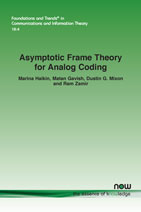Asymptotic Frame Theory for Analog Coding
By Marina Haikin, Amazon, Israel, mkokotov@gmail.com | Matan Gavish, The Hebrew University of Jerusalem, Israel, gavish@cs.huji.ac.il | Dustin G. Mixon, The Ohio State University, USA, mixon.23@osu.edu | Ram Zamir, Tel Aviv University, Israel, zamir@eng.tau.ac.il
Abstract
Over-complete systems of vectors, or in short, frames, play the role of analog codes in many areas of communication and signal processing. To name a few, spreading sequences for code-division multiple access (CDMA), over-complete representations for multiple-description (MD) source coding, space-time codes, sensing matrices for compressed sensing (CS), and more recently, codes for unreliable distributed computation. In this survey paper we observe an informationtheoretic random-like behavior of frame subsets. Such subframes arise in setups involving erasures (communication), random user activity (multiple access), or sparsity (signal processing), in addition to channel or quantization noise. The goodness of a frame as an analog code is a function of the eigenvalues of a sub-frame, averaged over all subframes (e.g., harmonic mean of the eigenvalues relates to least-square estimation error, while geometric mean to the Shannon transform, and condition number to the restricted isometry property).
Within the highly symmetric class of Equiangular Tight Frames (ETF), as well as other “near ETF” families, we show a universal behavior of the empirical eigenvalue distribution (ESD) of a randomly-selected sub-frame: (i) the ESD is asymptotically indistinguishable from Wachter’s MANOVA distribution; and (ii) it exhibits a convergence rate to this limit that is indistinguishable from that of a matrix sequence drawn from MANOVA (Jacobi) ensembles of corresponding dimensions. Some of these results follow from careful statistical analysis of empirical evidence, and some are proved analytically using random matrix theory arguments of independent interest. The goodness measures of the MANOVA limit distribution are better, in a concrete formal sense, than those of the Marchenko–Pastur distribution at the same aspect ratio, implying that deterministic analog codes are better than random (i.i.d.) analog codes. We further give evidence that the ETF (and near ETF) family is in fact superior to any other frame family in terms of its typical sub-frame goodness.
Asymptotic Frame Theory for Analog Coding
Over the past 2 decades, Frames have become tool in designing signal processing and communication systems where redundancy is a requirement. To name just a few, spreading sequences for code-division multiple access, over-complete representations for multiple-description source coding, space-time codes, sensing matrices for compressed sensing, and more recently, codes for unreliable distributed computation.
In this book the authors develop an information-theoretic characterization for frame subsets. These subframes arise in setups involving erasures (communication), random user activity (multiple access), or sparsity (signal processing), in addition to channel or quantization noise. Working at the intersection of information theory and neighboring disciplines, the authors provide a comprehensive survey for this new development that can drastically improve the performance of codes used in such systems.
The authors begin with an introduction to the underlying mathematical theory, including performance measures, frame theory and random matrix theory. They then proceed with two very important highlights that connect frame theory with random matrix theory and demonstrate the possibility that Equiangular Tight Frames provide superior performance over other classes.
This book provides a concise and in-depth starting point for students, researchers and practitioners working on a variety of communication and signal processing problems.
